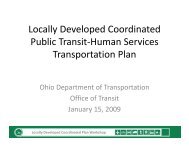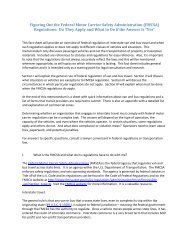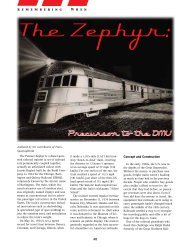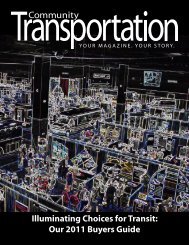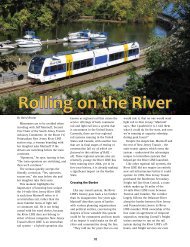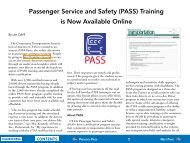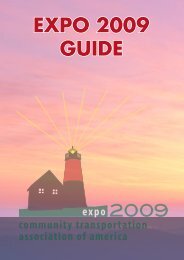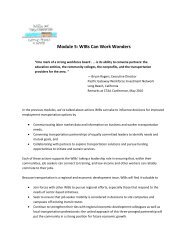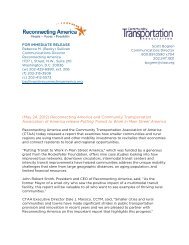San Luis Obispo - Caltrans - State of California
San Luis Obispo - Caltrans - State of California
San Luis Obispo - Caltrans - State of California
You also want an ePaper? Increase the reach of your titles
YUMPU automatically turns print PDFs into web optimized ePapers that Google loves.
SAN LUIS OBISPO REGION<br />
COORDINATED HUMAN SERVICES-PUBLIC TRANSPORTATION PLAN<br />
basis <strong>of</strong> a set <strong>of</strong> money income thresholds that vary by family size and composition. When a<br />
family’s income is less than the threshold for a family <strong>of</strong> that size and type, then that family and<br />
every individual in it is considered to be in poverty. These thresholds do not vary<br />
geographically. 5 The <strong>San</strong> <strong>Luis</strong> <strong>Obispo</strong> region’s proportion <strong>of</strong> 9 percent <strong>of</strong> persons at poverty<br />
levels is below the statewide mean <strong>of</strong> 13.3 percent and the comparable national mean <strong>of</strong> 13<br />
percent for the United <strong>State</strong>s as a whole. 6<br />
Disability Characteristics The second population group <strong>of</strong> interest is persons with disabilities.<br />
A disability is characterized by 2000 Census as persons with difficulty performing selective<br />
activities <strong>of</strong> daily living. While the 2000 Census has a number <strong>of</strong> variables related to disability<br />
status, this analysis uses the “go outside the home” disability, a self-reported characteristic that<br />
is likely to impact mobility outside the home. The U.S. Census Bureau classification <strong>of</strong> this<br />
disability includes those who because <strong>of</strong> a physical, mental or emotional condition lasting 6<br />
months or more, have difficulty going outside the home alone to shop or to medical<br />
appointments. For <strong>San</strong> <strong>Luis</strong> <strong>Obispo</strong> County this represented 2 percent <strong>of</strong> the total population <strong>of</strong><br />
adult’s ages 16 – 64 or 5,909 persons. For those ages 65 and over, this was another 2 percent<br />
<strong>of</strong> the total population, 5,316 seniors and 15 percent <strong>of</strong> the senior population.<br />
Persons with disabilities and persons <strong>of</strong> low income represent some overlap but also some<br />
difference. The Census Bureau documents that presence <strong>of</strong> a disability is associated with lower<br />
levels <strong>of</strong> income. In other studies, the Census Bureau reported that those with a low (less than<br />
half the median) relative income nationally, were 13.3 percent among those with no disability,<br />
30.4 percent among those with any disability and 42.2 percent among those with a severe<br />
disability. 7 Hence individuals with these characteristics are best represented in Table 3-11.<br />
Senior Characteristics The senior population has a variety <strong>of</strong> characteristics <strong>of</strong> interest to this<br />
discussion. The individuals over age 65 in the 2000 census numbered 35,679 or 14 percent <strong>of</strong><br />
the total <strong>San</strong> <strong>Luis</strong> <strong>Obispo</strong> County population. This is above the statewide average <strong>of</strong> 12<br />
percent. Low-income seniors, defined by income in relation to household size, are 1 percent <strong>of</strong><br />
the total county population and represent 6 percent <strong>of</strong> the senior population, age 65 and older.<br />
Seniors with disabilities were also identified in the 2000 census, a self-reported category and<br />
reflecting the individual’s perception. Five percent <strong>of</strong> seniors characterized themselves as<br />
disabled or 12,897 persons.<br />
A third group <strong>of</strong> potentially vulnerable seniors are those who are older than 75 years <strong>of</strong> age and<br />
those who are older than 85 years <strong>of</strong> age. Advanced age is associated with increased rates <strong>of</strong><br />
disability. 8 About 13,393 seniors are between the ages <strong>of</strong> 75 and 84, representing 38 percent <strong>of</strong><br />
the total county senior population and another 4,266 aged 85 and older, representing 12 percent<br />
<strong>of</strong> the county senior population <strong>San</strong> <strong>Luis</strong> Obipso region seniors 85+ are above the <strong>California</strong><br />
state proportion <strong>of</strong> 35.5 percent seniors age 85+, comprising 11.6 percent <strong>of</strong> the state’s seniors.<br />
The physiology <strong>of</strong> aging identifies age 75 as the age point at which the natural effects <strong>of</strong> the<br />
aging processes are increasingly likely to impinge upon lifestyle, health status and general wellbeing.<br />
This is not to say that every 75 year-old is going to have difficulty getting around. But it<br />
5 U.S. Bureau <strong>of</strong> the Census, Income, Earnings and Poverty Data from the 2005 American Community<br />
Survey. B.H Webster, A. Bishaw. Washington, DC, August 2006, p. 20.<br />
6 Income, Earnings and Poverty Data from the 2005 American Community Survey, p. 22.<br />
7 Current Population Reports, Series P23-194, Population Pr<strong>of</strong>ile <strong>of</strong> the United <strong>State</strong>s, 1997. p. 32.<br />
8 U.S. Bureau <strong>of</strong> the Census, Current Population Reports, Series P23-194, Population Pr<strong>of</strong>ile <strong>of</strong> the<br />
United <strong>State</strong>s, 1997. Washington DC, 1998, p. 50-51.<br />
46<br />
OCTOBER 2007



